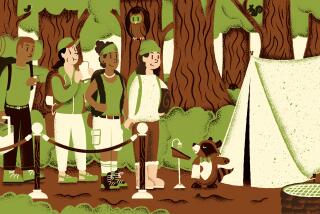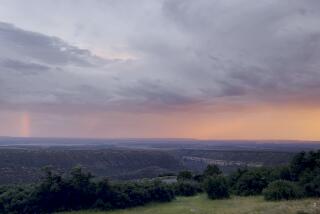Wheelin’ on the Natchez Trace
NATCHEZ TRACE PARKWAY, Tenn. — I’d been waiting years for this moment--riding my bike through the rolling hills of Tennessee on a sunny autumn day, doing 32 mph on a downhill grade, grinning like a fool and thinking I had the two-lane road to myself. Then a headlight flashed in my rearview mirror, the ground shook and a tremendous roar pierced my left ear. Then another, and another and another. You haven’t lived until you’ve had the thrill of being overtaken by 15 Harleys on the Natchez Trace Parkway.
My husband, Ralph, and I had traveled on this historic road that connects Nashville, to Natchez, Miss., several years ago, and I’d dreamed about biking it ever since. After the Sept. 11 attacks, we decided a drive through pastoral countryside would push urban terrorism from our minds. We would concentrate on history instead.
The parkway is a noodle-shaped national park, 444 miles long and a few hundred feet wide. No entrance fees are charged. Along its length are campgrounds, nature trails and scores of pullouts with interpretive signs that describe events as far back as 8000 BC.
What makes driving or biking the parkway such a pleasure is what it doesn’t have. Trucks are prohibited. So is any kind of advertising. There are no traffic signals, no mini-malls, no fast-food outlets. Imagine driving on a country lane roughly the distance Los Angeles is from San Francisco. It’s one of the United States’ most scenic drives, offering views of a grassy verge, with farmland and forests boasting 100 species of hardwood and pine trees from Tennessee’s Highland Rim to the Mississippi bottomlands of the Deep South.
I planned to ride alone 25 to 30 miles each morning. Ralph graciously offered to drive the “sag” or support wagon. We would meet for lunch in one of the numerous picnic sites along the route, then drive 80 to 90 miles more in the afternoon, going from Nashville to Natchez in four days.
The Natchez Trace Parkway commemorates and intertwines with the Old Natchez Trace. The original trace, or trail, was trampled into existence thousands of years ago by bison and other wild animals as they migrated from the south to salt licks in what is now Tennessee. Later, Indian tribes--the Natchez, the Choctaw and the Chickasaw--used it as a hunting and trade route.
Part of the Louisiana Territory, the trace was ruled at different times by France, Spain and England. In 1798 the Stars and Stripes waved above Natchez, making it the most southwesterly frontier outpost in the fledgling U.S.
At the time, the trail’s most frequent users were “Kaintucks,” pioneers from the Ohio River Valley who floated their goods down the Ohio and Mississippi rivers to Natchez and New Orleans. They sold tobacco, hemp, flour and even the flatboat itself, for lumber. Then they began the long homeward walk on the trace.
With the advent of steamboats in the early 1800s, the Natchez Trace was gradually abandoned until local interest revived it in the early 20th century. In 1938, Congress designated it a unit of the national park system.
On my first day, after I survived the hills and Harleys, Ralph and I met at the Meriwether Lewis Monument, where a log cabin serves as a mini-museum with information about the explorer’s life. The leader of the Lewis and Clark Expeditions was governor of Louisiana Territory when he stopped at a lonely inn along the trace on his way to Washington, D.C., in 1809; that night, at the age of 35, he died of gunshot wounds. Murder or suicide? It remains a mystery.
Because there are no restaurants along the parkway, we brought French bread, cheese and fruit and ate them in the shade of sky-scraping oak and hickory trees. No one else was there to disrupt the quiet.
At milepost 320 we detoured northwest an hour to visit 4,000-acre Shiloh National Military Park in Tennessee, site of one of the bloodiest battles of the Civil War. From April 6 to 7, 1862, in a battle historian Shelby Foote described as “a disorganized, murderous fistfight,” nearly 24,000 Union and Confederate troops were killed, were wounded or went missing. The cannons still rest where the armies placed them. The battle was particularly fierce at the Peach Orchard, where blossoms drifted onto dying soldiers like snow.
From Shiloh we followed the Rebs’ retreat to Corinth, Miss., where we had a large suite at the Victorian-style Generals’ Quarters Bed & Breakfast and refreshed ourselves in wicker chairs on its breezy veranda.
Next morning, after a breakfast of omelet, fresh fruit and the most deliciously flaky biscuits I’d ever eaten, we drove 33 miles back to the trace. Ralph let me off at Freedom Hills Overlook, Alabama’s highest point along the parkway.
For safety, I wore a helmet and checked my rearview mirror frequently. A flashing light on the bike’s seat post made me more visible in shady areas. I carried identification and our itinerary in case of an accident.
But I felt secure. The well-maintained parkway is a cyclist’s dream. I never saw a pothole, and in places the road surface is linoleum smooth.
On my second day I rode my bike 30 miles across two state lines, through the northwest corner of Alabama into Mississippi. I was hungry when I rolled into the picnic area at Pharr Mounds. Ralph had unfurled the red-and-white checked tablecloth, and we lunched looking out at an 85-acre field with eight dome-shaped earthen mounds built by hunter-gatherers between AD 1 and 200. Their purpose is unknown, but excavations in 1966 turned up pipes, pottery, jewelry and human remains.
We skipped a visit to Tupelo, Miss., where Elvis was born, instead forging ahead to the village at French Camp, so called because Louis Lefleur, a French Canadian, established a “stand,” or inn, for travelers here in 1812. Now there’s a boarding school and a bed-and-breakfast, where we had reserved a “rustic cabin” for the night. I like quilts and braided rugs, but my 6-foot, 5-inch husband didn’t enjoy sleeping with his feet hanging over the end of the double bed.
When we asked our host about dining options, she laughed and said, “There aren’t any!” We had to eat at the school’s cafeteria. The meal’s best feature was its cost--$6 total for both of us.
On my bike the next morning, the terrain had leveled out and traffic was even lighter. Only 18 cars overtook me in the first 10 miles. I stopped at an “Old Trace” sign, indicating one of the many places where the wilderness path kisses the parkway. Walking along the silent footpath, I was overtaken by imagined visions of the past. I jumped out of the way of a thundering herd of bison. Plying the leafy corridor were Chickasaws, boatmen, itinerant preachers, pioneers, soldiers, brutal highwaymen and post riders. I had read that they could deliver mail from Nashville to Natchez in 10 days on horseback. With that in mind, I swung back into the saddle.
Ralph was waiting for me at the Holly Hill Picnic Area, and after lunch we drove to Cypress Swamp, one of the park’s many nature trails. On a boardwalk, we crossed a swamp where bald cypress and tupelo trees grow out of the water. We didn’t see any alligators here, but along the parkway we saw plenty of other wildlife: deer, coyote and wild turkeys.
Leaving the parkway, we drove two miles west to Port Gibson, where we had reserved a room at Oak Square Plantation. Our large, antique-filled room with massive four-poster bed and canopy was in an annex of the 1850 Greek Revival house. Because the only nice restaurant in town was closed, we had burgers and shakes at the Sonic Drive-In.
We awoke to another blue-sky day. Fortified by grits, eggs and spicy sausage, I mounted my two-wheeler and set out for a morning ride. I met Ralph at Mount Locust, which traces its roots to 1780 when a one-room cabin was built on the site. Later it was expanded into an inn. Ranger Eric Chamberlain, a descendant of the family that owned the inn, painted a colorful picture of frontier life.
We made one more stop before the parkway ended. Emerald Mound, one of the largest ceremonial mounds in the United States, is 35 feet high and eight acres in area. We climbed the stairways to the highest point and looked out over a grassy expanse where ancestors of the Natchez Indians performed ceremonial dances, processions and religious rituals between 1250 and 1600.
Sitting in the sun, we fortified ourselves for the inevitable return to modern life. Biking and driving the trace had given us a new appreciation for the multilayered history of this onetime frontier known as the “Old Southwest,” now only a small part of our vast and great homeland.
Guidebook: Tracing the Parkway
* Getting there: From LAX, Southwest and American fly nonstop to Nashville, and United, Delta, TWA, Northwest, Continental and US Airways have connecting flights. Restricted round-trip fares begin at $198.
The Natchez Trace Parkway can be driven in two or three days. The only gas station is at milepost 193.1.
I took my own bike, but bike rentals are available in Nashville and Natchez. * Where to stay: We stayed at B&Bs; near the parkway. The night before our journey, we chose the Chigger Ridge Bed & Breakfast near the parkway’s northern terminus. 1060 Highway 70 West, Box 349, Pegram, TN 37143; (615) 952-4354, https://www.bbonline.com/tn/chigger. Doubles $109.
In Corinth, Miss., the Generals’ Quarters Bed & Breakfast Inn, an elegant Victorian, has business amenities and Southern charm. 924 Fillmore St., 38834; (662) 286-3325, fax (662) 297-8188, https://www.thegeneralsquarters.com. Doubles $75-$120.
In Tupelo, Miss., we stayed in the Mockingbird Inn, 305 N. Gloster St., 38804; (662) 841-0286, fax (662) 840-4158, https://www.bbonline.com/ms/mockingbird. Doubles $79-$129.
Rooms also can be booked through the Natchez Bed & Breakfast Reservation Service (run by Bill and Kay Jones), P.O. Box 193, Hampshire, TN 38461; (800) 377-2770 or (931) 285-2777, https://www.bbonline.com/natcheztrace.
Besides three campgrounds at Meriwether Lewis (milepost 385.9), Jeff Busby (milepost 193.1) and Rocky Springs (milepost 54.8), there are bike-only campgrounds at (north to south) mileposts 408, 327, 266, 234 and 159.
* Where to eat: We had good breakfasts at the B&Bs.; You will have to carry your own lunch because there are no food services on the parkway.
In Tupelo, these restaurants come highly recommended by the Tupelo Visitors Bureau: For steak and seafood, Gloster 205, 205 N. Gloster St., (662) 842-7205.
For Southern specialties--catfish and hush puppies--Malone’s Catfish House, 1369 Road 41, (662) 842-2747.
For Italian and Greek cuisine, Vanelli’s, 1302 N. Gloster St., (662) 844-4410.
* For more information: For a Natchez Trace Parkway official map and guide, contact the Superintendent, 2680 Natchez Trace Parkway, Tupelo, MS 38801-9718; (800) 305-7417 or (662) 680-4025, https://www.nps.gov/natt.
More to Read
Sign up for The Wild
We’ll help you find the best places to hike, bike and run, as well as the perfect silent spots for meditation and yoga.
You may occasionally receive promotional content from the Los Angeles Times.






